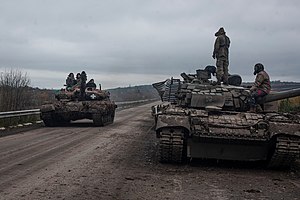2319 March on Nojawa: Difference between revisions
No edit summary |
No edit summary |
||
| Line 17: | Line 17: | ||
| map_label = | | map_label = | ||
| territory = | | territory = | ||
| result = | | result = [[National Defense Army]] victory | ||
| status = | | status = | ||
| combatants_header = | | combatants_header = | ||
Revision as of 18:32, 11 October 2024
| 2319 Carinansian coup | |||||||
|---|---|---|---|---|---|---|---|
| Part of 2318-2320 Carinansian political crisis | |||||||
 H-62 tanks seizing a road near Nojawa during the coup | |||||||
| |||||||
| Belligerents | |||||||
| Government of Enrique Campos | National Defense Army | ||||||
| Commanders and leaders | |||||||
| Enrique Campos | Luis Rezende | ||||||
The 2319 March on Nojawa, also known as the Rezende Coup, was a successful power grab by Luis Rezende, Secretary of Defense and commander of the National Defense Army (NDA), to seize control of Carinansia from President Enrique Campos. Rezende was a staunch member of the newly-emerged totalitarian Communalist faction within the ruling Serene Revivalist Party, which prioritized national defense, the maintenance of strict state controls, and the perpetuation of a "frozen" state of war with the Azlan Empire. The Communalists feared that ending the war would lead to the loss of dictatorial powers and a return to democratic norms, which they vehemently opposed. They further advocated for the complete suspension of the constitution until further notice
On July 10th, 2319, Rezende mobilized 20 thousand members of the NDA to march through the streets of Nojawa, in a decisive show of force against the increasingly isolated Campos administration. This massive demonstration of power culminated in a two-day blockade of the Casa Central, where Campos had taken refuge. The local military garrison, loyal to Campos, attempted to defend the palace, resulting in fierce urban combat with Rezende’s well-organized and heavily armed paramilitary forces. The subsequent battle took 78 defending and 13 attacking lives, and resulted in a regrouping operation before attacking the complex.
However, by July 12th, as the NDA forces tightened their grip on the capital and support within his administration crumbled, Campos saw no option but to resign. Rezende immediately assumed the presidency, solidifying the Communalist faction’s control over Carinansia. His regime, however, quickly became one of the darkest periods in Carinansian history, marked by brutal repression, severe police state measures, and widespread human rights abuses. This era is viewed as the most oppressive in Carinansian history, second only to the so-called Epoca solitaria during the Galvez, and Ferrant presidencies.
Rezende’s ensuing dictatorship was brief but devastating, and the increasing disunity within the Serene Revivalist Party during his rule weakened its grip on power. This disarray allowed for the emergence of the Anti-Fascist Coalition, a broad political alliance that rapidly gained support across the country and within the National Congress. Less than two months after Rezende's resignation in late 2320, the Anti-Fascist Coalition successfully assumed the presidency, dismantling the Serene Revivalist dictatorship.